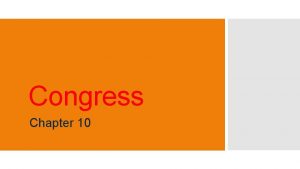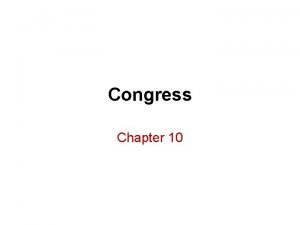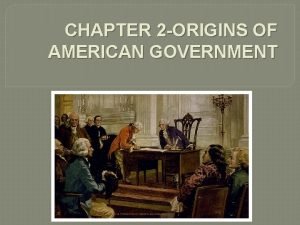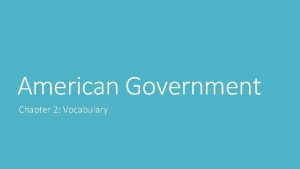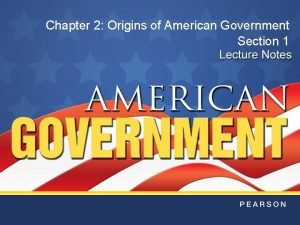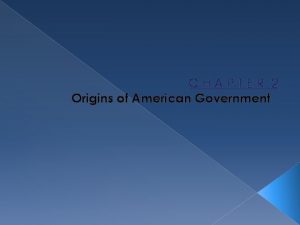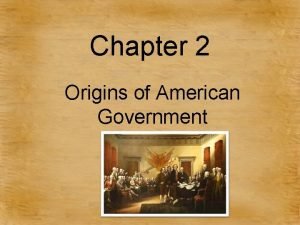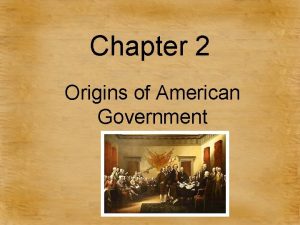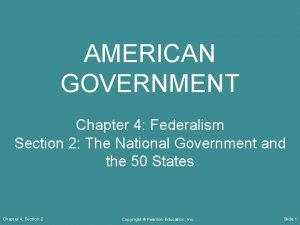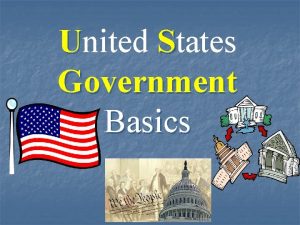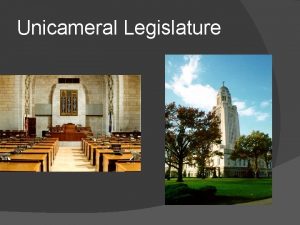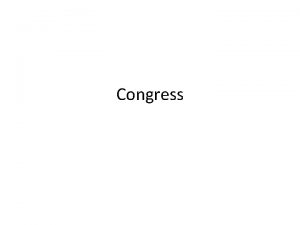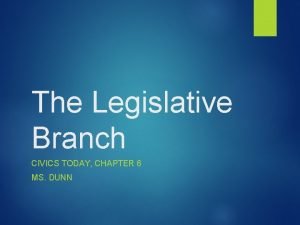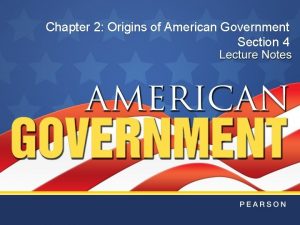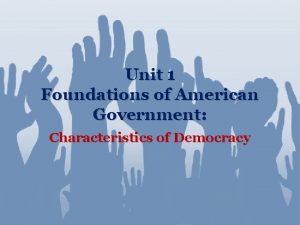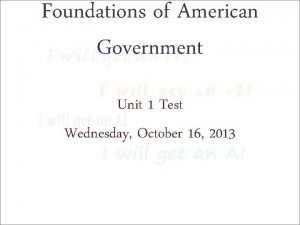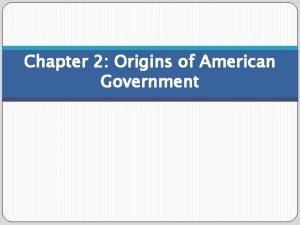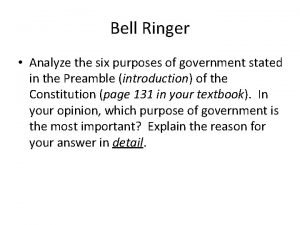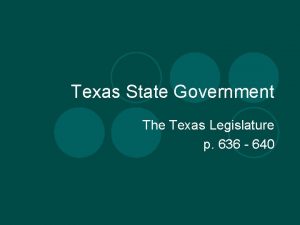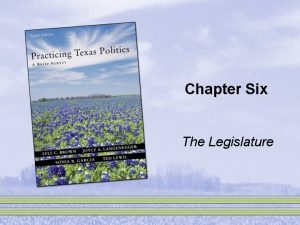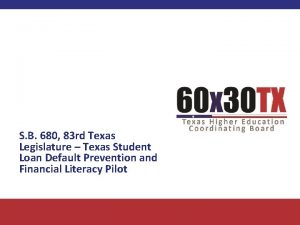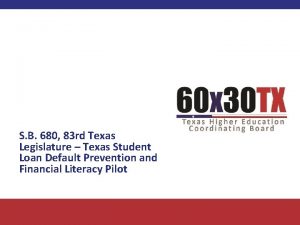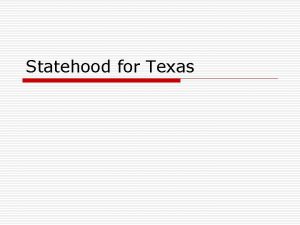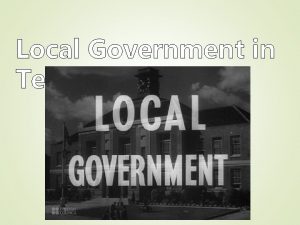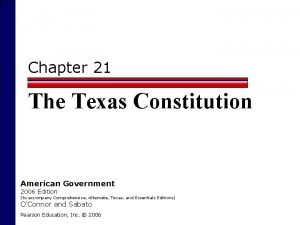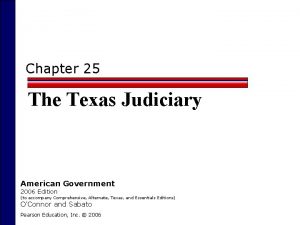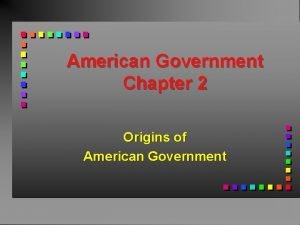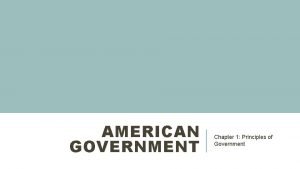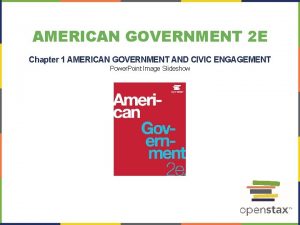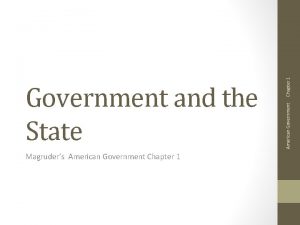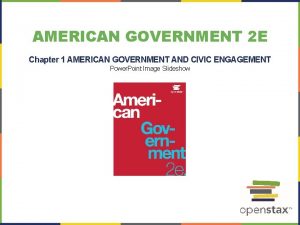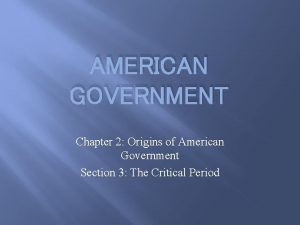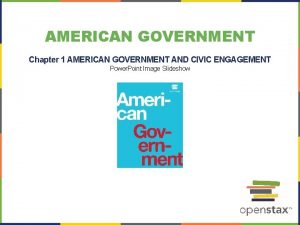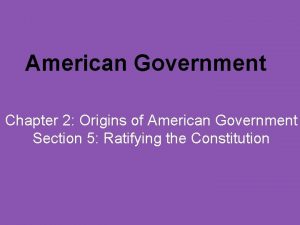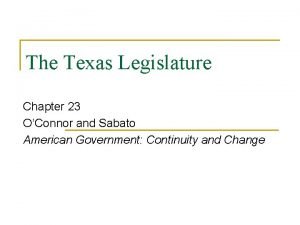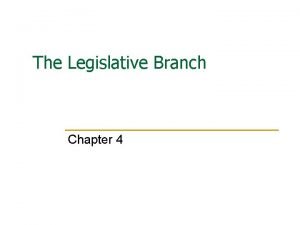Chapter 23 The Texas Legislature American Government 2006

































- Slides: 33

Chapter 23 The Texas Legislature American Government 2006 Edition (to accompany Comprehensive, Alternate, Texas, and Essentials Editions) O’Connor and Sabato Pearson Education, Inc. © 2006

The Texas Legislature o Serves the following functions: To represent the people in government. To legislate. To budget and tax. To perform constituent casework. To consider constitutional amendments for the Texas and U. S. constitutions. n To confirm the governor’s appointees. n To redistrict itself and the U. S. congressional districts in Congress. n To impeach and remove from office corrupt officials. n n n Pearson Education, Inc. © 2006

The Roots of the Legislative Branch o Predecessors were n Mexican legislatures n A series of elected conventions n Congress of the Republic of Texas o Bicameral Congress o Convened in 1836 with 30 representatives and 14 senators o Senators served three-year terms; House members elected for one-year terms o Nine Congresses, one year each in length o Dissolved in 1846 o Legislature of State of Texas convened in 1846 Pearson Education, Inc. © 2006

The State Constitution and the Legislative Branch of Government o Today the bicameral Texas legislature consists of a Senate of 31 members and a House of 150 members. n Small Senate but large House n 1876 Texas Constitution set the size of the Senate but allowed the House to grow n Both must pass a bill for it to become a law n Differing duties as well Pearson Education, Inc. © 2006

Constitutional Requirements Affecting Texas Legislators Pearson Education, Inc. © 2006

Constitutional Provisions Affecting Legislators o Length of Terms n Representatives elected for two-year terms n Senators for four-year terms o Senate elections are staggered: 15 seats up and then 16 seats two years later o After redistricting, all senators must run, draw lots to see who serves a two-year term versus a four-year term o Compensation n Among the lowest paid in the nation n Last raise was in 1974 Pearson Education, Inc. © 2006

Sessions of the Legislature o Biennial legislature n Meets regularly every two years n Were common in the 19 th and 20 th century n Concept of the citizen legislature o Regular session n The biennial 140 -day session of the Texas legislature, beginning in January of oddnumbered years o Special (called) session n A legislative session of up to 30 days, called by the governor, during an interim between regular sessions Pearson Education, Inc. © 2006

Legislative Membership: Representing the Public o Variables that affect members’ elections include n Their districts and any redistricting that occurs n No term limits Pearson Education, Inc. © 2006

Redistricting o Single-member district n n An election system for legislative bodies in which each legislator runs from and represents a single district, rather than the entire geographic area encompassed by the government Controversies in Texas over redistricting o 2001 legislature and governor could not reach an o o accommodation Legislative Redistricting Board (4 Republicans and 1 Democrat) approved plans that favored Republicans Lawsuits resulted but plan was approved with modifications Congressional redistricting left to the courts Hide and Seek Pearson Education, Inc. © 2006

Reelection Rates and Turnover Membership o Early on, few legislators sought a second term. o Now most incumbents seek reelection and most are successful. o Nationally, state legislative turnover is about 27%. Texas rate is lower. o Election after redistricting most volatile. Pearson Education, Inc. © 2006

Personal and Political Characteristics of Members o Occupation n Many lawyers, businesspeople and professionals, but number of teachers, preachers, public organizers and former legislative aides is increasing. n The pay is low and the job is part-time. o Religion n Baptists dominated, but by the 1990 s Catholics were the largest group, followed by Baptists, Methodists, and Episcopalians. Pearson Education, Inc. © 2006

Personal and Political Characteristics of Members o Gender n Anglo males have dominated; recently women and minority members have increased in number. o Age n Most Texas legislators are in their forties or fifties in age. n House members tend to be younger relative to Senate members. Pearson Education, Inc. © 2006

Personal and Political Characteristics of Members o Political Party n Historically, Democrats have won far more seats in the Texas legislature than have Republicans. n Republicans have grown in power. Won majority in Texas Senate in 1996, 1998, 2000 and 2002. They won a majority in the House in 2002 and 2004. n In 2005, Democrats controlled 24 state senate seats, Republicans controlled 24. One equally divided. o Ideology n Democrats tend to be liberals and populists; Republicans tend to be libertarians and conservatives. Pearson Education, Inc. © 2006

How the Texas Legislature is Organized o Leaders n President of the Texas Senate n Pro-Tempore n Speaker of the Texas House o Committees o Legislative Party Caucuses Pearson Education, Inc. © 2006

Types of Legislative Committees Pearson Education, Inc. © 2006

Legislative Committees of the 78 Legislature, 2003 -2004 Pearson Education, Inc. © 2006

Leadership and Opposition in the House o Texas Constitution requires that members of the House choose a leader (called the Speaker). n 20 th-century norm is for the Speaker to serve two terms n 1973 Dirty Thirty Reforms o Speaker voting is open and public o Some fear of retaliation n Pattern today is more than two terms. Pearson Education, Inc. © 2006

Texas House Membership, 1975 -2005 Pearson Education, Inc. © 2006

The Speaker’s Race o The campaign to determine who shall be the speaker of the Texas House for a given biennium n Vast amounts of money raised n Much of this money used to to help elect legislators who will be pledged to the speaker candidate n Pledge cards o Sharpstown Scandal o Speaker has a team n The leadership team in the House, consisting of the speaker and his/her most trusted allies among the members, most of whom the speaker appoints to chair House committees Pearson Education, Inc. © 2006

House Opposition and the Political Parties o In the past, opposition to the speaker and his/her team has NOT been organized along party lines, but this is NOW changing. o Nonparty Legislative Caucuses n An organization of legislators that is based on some attribute other than party affiliation n Usually emerge in the absence of strong parties n Ex: House Study Group Pearson Education, Inc. © 2006

Leadership and Opposition in the Senate o Lieutenant Governor serves as president of the Senate n Not a member of the senate n Votes only in case of a tie o Often a stepping stone to other offices o One of the most powerful lieutenant governors in the states n Has power to appoint committee chairs o Members of the senate write the rules that give the Lt. Governor his/her power Pearson Education, Inc. © 2006

Leadership and Opposition in the Senate o Senate Two-Thirds Rule n The rule in the Texas Senate requiring that every bill win a vote of two-thirds of the senators present to suspend the Senate’s regular order of business, so that the bill may be considered n Tends to protect the opposition n Makes leadership-opposition blocs more fluid in the Senate n Greater protection of minority rights than in the Texas House Pearson Education, Inc. © 2006

The Law-Making and Budgeting Function of the Legislature o Bill: A proposed law o Joint resolution n A legislative document that either proposes an amendment to the Texas Constitution or ratifies an amendment to the U. S. Constitution o Simple resolution n A legislative document proposing an action that affects only the one chamber in which it is being considered, such as a resolution to adopt House rules or to commend a citizen o Concurrent resolution n A legislative document intended to express the will of both chambers of the legislature, even though it does not possess the authority of law Pearson Education, Inc. © 2006

How a Bill Becomes a Law o o o Bill must be read on three separate days in each chamber Must pass both chambers in the exact form Legislator files a bill or resolution and clerk assigns it a number n No requirement that a bill be introduced in both chambers Bill then goes to committee Committee holds hearings, most of them public hearings n Open to all and votes must be taken in open meetings n If it goes to subcommittee, the subcommittee chair decides n to have a public hearing or a formal meeting At this point the House and Senate diverge in the legislative process Pearson Education, Inc. © 2006

How a Bill Becomes a Law o House n House Calendars Committee n 1993 Reforms Pearson Education, Inc. © 2006 o Senate n n n Intent Calendar Notice of Intent Bottleneck Bill Killer Bees 2/3 s Rule

The Bill Reaches the Floor o Quorum n o First Reading n o Occurs when debate and consideration of amendments occur before the whole chamber Third Reading n o Texas Constitution requires three readings of a bill by the legislature; first reading is when the bill is introduced, its caption is read aloud, and it is referred to committee Second Reading n o The minimum number required to conduct business The final reading in a chamber unless the bill returns from the other chamber with amendments Filibuster is a formal way of halting action on a bill by means of long speeches or unlimited debate in the Senate Pearson Education, Inc. © 2006

The Bill Reaches the Floor o An amendment must be germane to the bill (related to the topic), but this is a matter of interpretation by the speaker of the House or Senate president. o In the chamber in which the bill originated, when the final vote on a bill on third reading is favorable, the bill is considered engrossed. n An engrossed bill is then sent to the other chamber by a staff messenger. n It then goes through the referral and committee process and may or may not make it to the floor of the second chamber. Pearson Education, Inc. © 2006

Two Bills into One: The Final Stages o Many bills are amended in the second chamber, so an additional step is needed to get both bills into one form. n The original chamber could simply vote to concur with the amendments placed on the bill or, n It may vote to NOT concur and request a conference committee to adjust the differences. n If approved, it is an enrolled bill and goes to the governor. n He may sign it, ignore it (and it goes into effect anyway) or veto it. Pearson Education, Inc. © 2006

A Glossary of Legislative Lingo Pearson Education, Inc. © 2006

The Budgeting Process o Biennial legislative sessions necessitate biennial budgets. o 1931 the Texas legislature designated the governor as the state’s chief budget officer, but the same law gave the State Board of Control responsibility for preparing the budget. o 1951 the budget function went to the governor’s office and stayed there. o Legislative Budget Board was also created. o Both prepare budgets for the legislature to consider. Pearson Education, Inc. © 2006

The Budgeting Process o Balanced budget required by the Texas constitution n Deficit spending: government spending in the current budget cycle that exceeds government revenue. n Debt: the total outstanding amount the government owes as a result of borrowing in the past o Budget execution authority: The authority to move money from one program to another program or from one agency to another agency. Pearson Education, Inc. © 2006

Factors that Influence How Legislators Make Decisions o Growth of legislative staff o Efforts to increase information n Technical assistance n Specialized information o Legislative Council o Legislative Budget Board n Political assistance o Lobbyists Pearson Education, Inc. © 2006

The Legislator and the Governor o Strong players in the legislative process n Have things that legislators want: o Emergency declaration for their bills o Adding their bills to a call for a special session o Signing their bills n Special Sessions n Party loyalty n Veto power Pearson Education, Inc. © 2006
 Chapter 10 the national legislature
Chapter 10 the national legislature The national legislature chapter 10
The national legislature chapter 10 Chapter 2 american government
Chapter 2 american government Chapter 2 origins of american government vocabulary
Chapter 2 origins of american government vocabulary Chapter 2 origins of american government answer key
Chapter 2 origins of american government answer key Chapter 2 origins of american government worksheet answers
Chapter 2 origins of american government worksheet answers Origins of american government chapter 2
Origins of american government chapter 2 Chapter 2 origins of american government
Chapter 2 origins of american government American government chapter 4
American government chapter 4 Bicameral legislature
Bicameral legislature Unicameral legislature
Unicameral legislature Unicameral vs bicameral legislature
Unicameral vs bicameral legislature Why does the constitution establish a bicameral legislature
Why does the constitution establish a bicameral legislature Why did the framers create a bicameral legislature
Why did the framers create a bicameral legislature Bicameral meaning
Bicameral meaning Bicameral legislature
Bicameral legislature Ymca texas youth and government
Ymca texas youth and government National powers
National powers Origins of american government section 4
Origins of american government section 4 Ap government and politics unit 1 study guide
Ap government and politics unit 1 study guide Unit 1 foundations of american government
Unit 1 foundations of american government Origins of american government section 1
Origins of american government section 1 Foundations of american government unit 1 test review
Foundations of american government unit 1 test review Origins of american government section 1
Origins of american government section 1 What are six purposes of the american system of government
What are six purposes of the american system of government Hình ảnh bộ gõ cơ thể búng tay
Hình ảnh bộ gõ cơ thể búng tay Ng-html
Ng-html Bổ thể
Bổ thể Tỉ lệ cơ thể trẻ em
Tỉ lệ cơ thể trẻ em Chó sói
Chó sói Chụp phim tư thế worms-breton
Chụp phim tư thế worms-breton Chúa sống lại
Chúa sống lại Môn thể thao bắt đầu bằng từ chạy
Môn thể thao bắt đầu bằng từ chạy Thế nào là hệ số cao nhất
Thế nào là hệ số cao nhất
